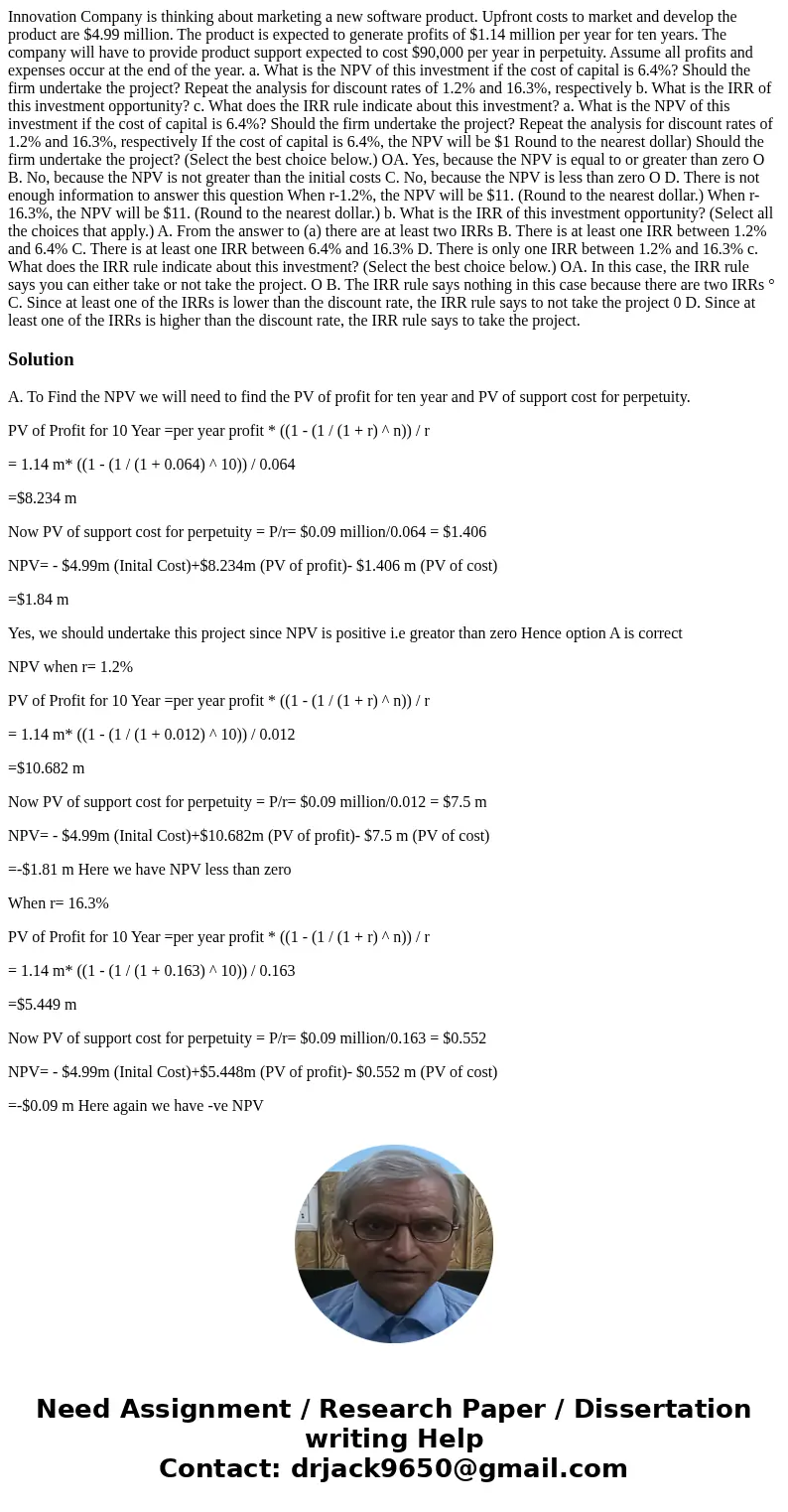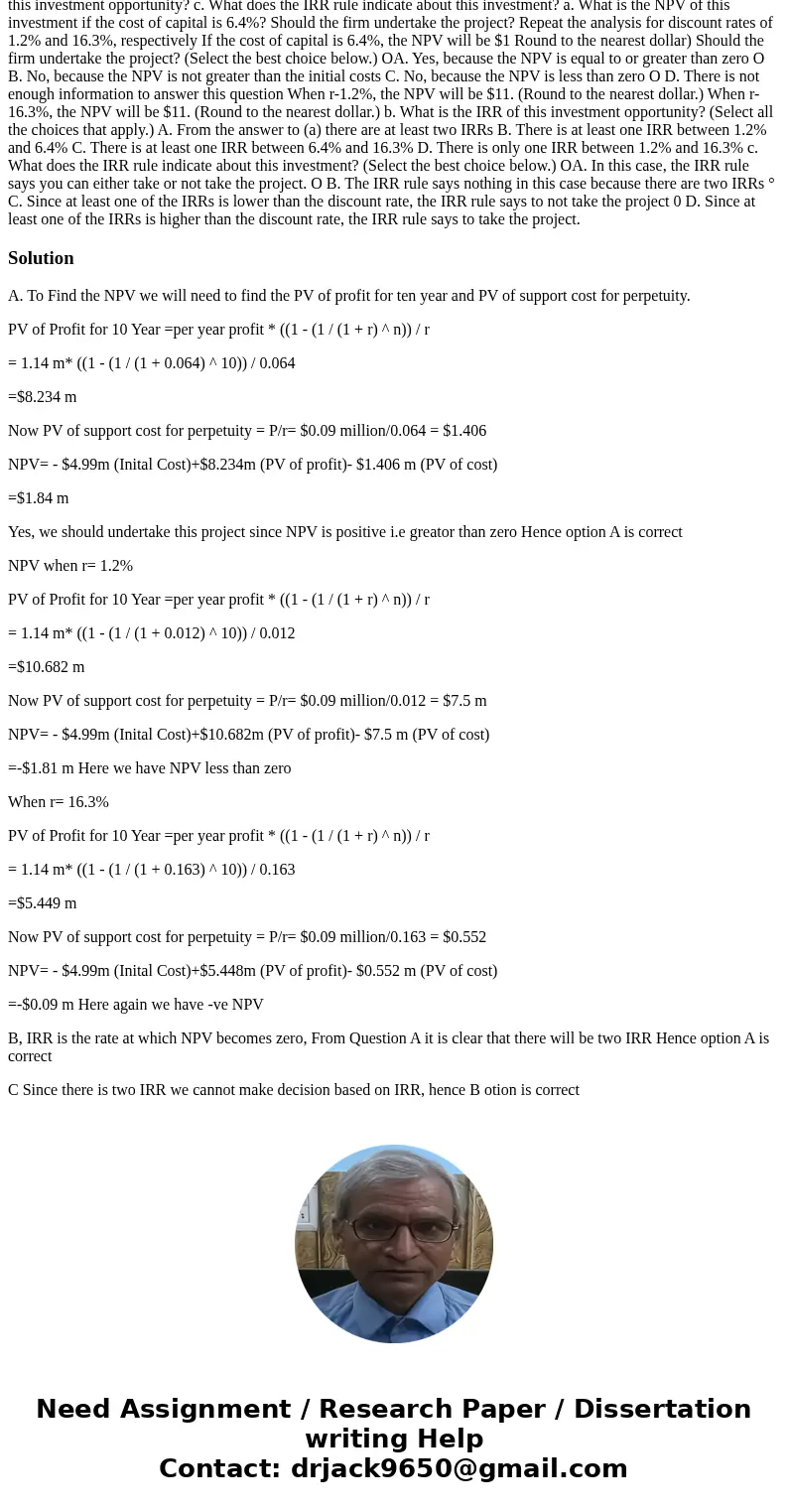Innovation Company is thinking about marketing a new software product. Upfront costs to market and develop the product are $4.99 million. The product is expected to generate profits of $1.14 million per year for ten years. The company will have to provide product support expected to cost $90,000 per year in perpetuity. Assume all profits and expenses occur at the end of the year. a. What is the NPV of this investment if the cost of capital is 6.4%? Should the firm undertake the project? Repeat the analysis for discount rates of 1.2% and 16.3%, respectively b. What is the IRR of this investment opportunity? c. What does the IRR rule indicate about this investment? a. What is the NPV of this investment if the cost of capital is 6.4%? Should the firm undertake the project? Repeat the analysis for discount rates of 1.2% and 16.3%, respectively If the cost of capital is 6.4%, the NPV will be $1 Round to the nearest dollar) Should the firm undertake the project? (Select the best choice below.) OA. Yes, because the NPV is equal to or greater than zero O B. No, because the NPV is not greater than the initial costs C. No, because the NPV is less than zero O D. There is not enough information to answer this question When r-1.2%, the NPV will be $11. (Round to the nearest dollar.) When r-16.3%, the NPV will be $11. (Round to the nearest dollar.) b. What is the IRR of this investment opportunity? (Select all the choices that apply.) A. From the answer to (a) there are at least two IRRs B. There is at least one IRR between 1.2% and 6.4% C. There is at least one IRR between 6.4% and 16.3% D. There is only one IRR between 1.2% and 16.3% c. What does the IRR rule indicate about this investment? (Select the best choice below.) OA. In this case, the IRR rule says you can either take or not take the project. O B. The IRR rule says nothing in this case because there are two IRRs ° C. Since at least one of the IRRs is lower than the discount rate, the IRR rule says to not take the project 0 D. Since at least one of the IRRs is higher than the discount rate, the IRR rule says to take the project.
A. To Find the NPV we will need to find the PV of profit for ten year and PV of support cost for perpetuity.
PV of Profit for 10 Year =per year profit * ((1 - (1 / (1 + r) ^ n)) / r
= 1.14 m* ((1 - (1 / (1 + 0.064) ^ 10)) / 0.064
=$8.234 m
Now PV of support cost for perpetuity = P/r= $0.09 million/0.064 = $1.406
NPV= - $4.99m (Inital Cost)+$8.234m (PV of profit)- $1.406 m (PV of cost)
=$1.84 m
Yes, we should undertake this project since NPV is positive i.e greator than zero Hence option A is correct
NPV when r= 1.2%
PV of Profit for 10 Year =per year profit * ((1 - (1 / (1 + r) ^ n)) / r
= 1.14 m* ((1 - (1 / (1 + 0.012) ^ 10)) / 0.012
=$10.682 m
Now PV of support cost for perpetuity = P/r= $0.09 million/0.012 = $7.5 m
NPV= - $4.99m (Inital Cost)+$10.682m (PV of profit)- $7.5 m (PV of cost)
=-$1.81 m Here we have NPV less than zero
When r= 16.3%
PV of Profit for 10 Year =per year profit * ((1 - (1 / (1 + r) ^ n)) / r
= 1.14 m* ((1 - (1 / (1 + 0.163) ^ 10)) / 0.163
=$5.449 m
Now PV of support cost for perpetuity = P/r= $0.09 million/0.163 = $0.552
NPV= - $4.99m (Inital Cost)+$5.448m (PV of profit)- $0.552 m (PV of cost)
=-$0.09 m Here again we have -ve NPV
B, IRR is the rate at which NPV becomes zero, From Question A it is clear that there will be two IRR Hence option A is correct
C Since there is two IRR we cannot make decision based on IRR, hence B otion is correct


 Homework Sourse
Homework Sourse